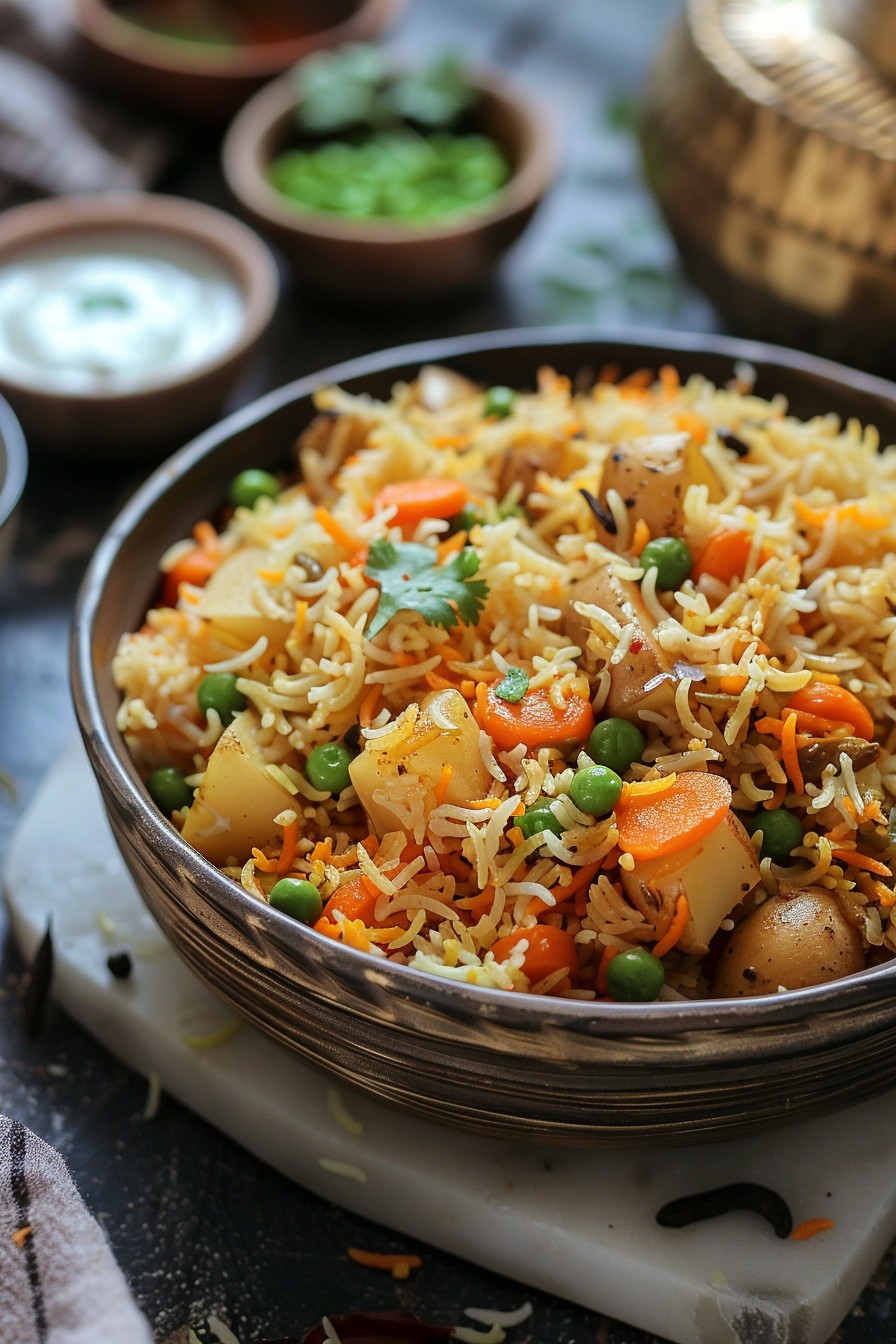Kickstart your culinary adventure with this vegetable biryani recipe that promises a burst of flavors in every spoonful. Perfect for weeknight dinners or special occasions, this dish is a testament to the magic of spices and vegetables coming together.
Why This Recipe Works
- The layering technique ensures every grain of rice is infused with aromatic spices.
- Using basmati rice guarantees a fluffy and fragrant outcome.
- A mix of fresh vegetables adds color, texture, and nutrition.
- The slow cooking method allows the flavors to meld beautifully.
- It’s a one-pot meal that simplifies cleanup without compromising on taste.
Ingredients
- 2 cups basmati rice, soaked for 30 minutes
- 1 cup mixed vegetables (carrots, peas, potatoes), diced
- 1 large onion, thinly sliced
- 2 tomatoes, chopped
- 1/2 cup plain yogurt
- 2 tbsp biryani masala
- 1 tbsp ginger-garlic paste
- 4 cups water
- 2 tbsp ghee
- Salt to taste
Equipment Needed
- Large pot with lid
- Mixing bowls
- Measuring cups and spoons
- Knife and cutting board
Instructions

Prepare the Rice
Drain the soaked basmati rice and set aside. In a large pot, bring 4 cups of water to a boil. Add the rice and cook until it’s 70% done, about 5 minutes. Drain and set aside. This partial cooking ensures the rice will finish cooking perfectly during the layering process.
Sauté the Vegetables
Heat ghee in the same pot over medium heat. Add the sliced onions and sauté until golden brown. Stir in the ginger-garlic paste and biryani masala, cooking for a minute until fragrant. Add the diced vegetables and chopped tomatoes, cooking until the vegetables are slightly tender.
Layer the Biryani
Spread half of the partially cooked rice over the vegetable mixture. Drizzle with half of the yogurt. Repeat the layers with the remaining rice and yogurt. Cover with a tight-fitting lid and cook on low heat for 20 minutes, allowing the flavors to meld.
Let It Rest
Turn off the heat and let the biryani sit covered for 10 minutes. This resting period allows the rice to absorb any remaining moisture and the flavors to deepen.
Serve and Enjoy
Fluff the biryani gently with a fork, ensuring the layers remain distinct. Serve hot with raita or a side salad for a complete meal.
Tips and Tricks
For an even more aromatic biryani, add a few strands of saffron soaked in warm milk to the layers. If you’re short on time, using frozen mixed vegetables is a great shortcut. To achieve the perfect dum (slow cooking) effect, seal the pot’s lid with dough or a wet cloth to trap the steam. Experiment with the amount of biryani masala to suit your spice preference. Lastly, always use a heavy-bottomed pot to prevent burning.
Recipe Variations
- Add paneer or tofu for a protein boost.
- Swap basmati rice with brown rice for a healthier version.
- Include nuts and dried fruits for a richer texture and taste.
- Use coconut milk instead of water for a creamy twist.
- Incorporate different vegetables like bell peppers or cauliflower for variety.
Frequently Asked Questions
Can I make this biryani in a pressure cooker?
Yes, you can adapt this recipe for a pressure cooker. After layering the rice and vegetables, cook on high for one whistle, then let the pressure release naturally for about 10 minutes. This method speeds up the cooking process but still delivers delicious results.
How can I store leftover biryani?
Leftover biryani can be stored in an airtight container in the refrigerator for up to 3 days. Reheat it in a microwave or on the stovetop with a splash of water to keep the rice moist.
Is there a vegan version of this recipe?
Absolutely! Simply replace the ghee with oil and use a dairy-free yogurt alternative. The rest of the ingredients are naturally vegan, making it easy to adapt this recipe to a vegan diet.
Summary
This vegetable biryani recipe is a celebration of flavors, colors, and textures. With its aromatic spices, fluffy rice, and tender vegetables, it’s a dish that’s sure to impress. Whether you’re a seasoned cook or a beginner, this recipe is straightforward and adaptable to your taste preferences.